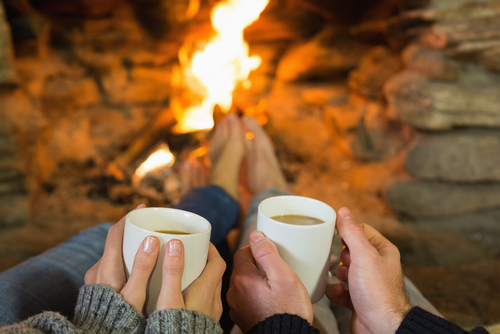Lighting a Fire in Your New Fireplace
Bill Reilly Team October 18, 2016
 As the weather chills, snow falls and socializing moves indoors, what could be more inviting than a warm cup of cocoa in front of a bright crackling fire? If your new home has a wood fireplace, here are some basics on fireplace care.
Hire a chimney sweep
Not just characters in Mary Poppins tales, chimney sweeps are professionals trained to protect your fireplace and your home from damage, debris and hazards. Certified chimney sweeps inspect your fireplace for damage to the brickwork and mortar, cracks in the tile flue liners, blockages such as bird, raccoon or squirrel nests, a build of leaves, soot, creosote and other potential causes of house fires and smoke damage.
As the weather chills, snow falls and socializing moves indoors, what could be more inviting than a warm cup of cocoa in front of a bright crackling fire? If your new home has a wood fireplace, here are some basics on fireplace care.
Hire a chimney sweep
Not just characters in Mary Poppins tales, chimney sweeps are professionals trained to protect your fireplace and your home from damage, debris and hazards. Certified chimney sweeps inspect your fireplace for damage to the brickwork and mortar, cracks in the tile flue liners, blockages such as bird, raccoon or squirrel nests, a build of leaves, soot, creosote and other potential causes of house fires and smoke damage.
- Hire a chimney sweep before you light the first fire.
- If your certified chimney sweep suggests repairs to your fireplace or chimney, do not ignore their advice.
- Have your chimney inspected at least once a year.
- Make sure smoke alarms are working correctly and have fresh batteries. You should have a smoke detector on every level of your home, inside each bedroom and outside the sleeping area. All alarms should be connected so that when one alarm is triggered, they all sound.
- Test your carbon monoxide detector. If you do not have one, get one installed.
- Install a chimney cap to keep birds and small debris out of the chimney and fireplace.
- Keep the damper closed when the fireplace is not in use. Not only does this keep debris from falling into your fireplace, it keeps the heat from escaping through the flue.
Property lit fires
Once you know your fireplace is safe to use, learn how to light a fire. While you may find several "sure-fire" ways to do the job, make sure to follow all safety procedures when doing so.
- Open the damper.
- Prime the flue. If your chimney is on the outside of the house, you'll need to warm it up before lighting the fire to avoid smoke descending into the room. If your fireplace has a gas pipe, turn on and light the gas for a few minutes until the flue warms and you feel the air drafting into and up the chimney before you add wood to the fire. If you do not have a gas starter, here are instructions for safely priming your flue.
- Experts suggest building an "upside down" fire for a cleaner, longer lasting fire. To set up your upside down fire, stack larger fuel logs on the fire grate. Place smaller logs on top of these, and then place kindling and twigs on top of the stack. Lastly, top of your fire with balls of scrunched up newspaper or other tender. Light the fire from the top. As the paper burns, the smoke will exit the chimney while the paper lights the twigs and kindling. As the kindling forms coals, it will like the smaller logs and they in turn will light the larger logs.
- Allow an ash bed to form under the grate. An inch or two of ash insulates your fireplace and keeps the fire burning hotter. However, don't allow too much ash to build up, since that will dampen your fire and make it harder to light the next time.
Stay safe and warm
Enjoy your new fireplace, but stay safe as well. If you need recommendations for a professional chimney sweep, let us know.
Compliments of Virtual Results
 As the weather chills, snow falls and socializing moves indoors, what could be more inviting than a warm cup of cocoa in front of a bright crackling fire? If your new home has a wood fireplace, here are some basics on fireplace care.
Hire a chimney sweep
Not just characters in Mary Poppins tales, chimney sweeps are professionals trained to protect your fireplace and your home from damage, debris and hazards. Certified chimney sweeps inspect your fireplace for damage to the brickwork and mortar, cracks in the tile flue liners, blockages such as bird, raccoon or squirrel nests, a build of leaves, soot, creosote and other potential causes of house fires and smoke damage.
As the weather chills, snow falls and socializing moves indoors, what could be more inviting than a warm cup of cocoa in front of a bright crackling fire? If your new home has a wood fireplace, here are some basics on fireplace care.
Hire a chimney sweep
Not just characters in Mary Poppins tales, chimney sweeps are professionals trained to protect your fireplace and your home from damage, debris and hazards. Certified chimney sweeps inspect your fireplace for damage to the brickwork and mortar, cracks in the tile flue liners, blockages such as bird, raccoon or squirrel nests, a build of leaves, soot, creosote and other potential causes of house fires and smoke damage.